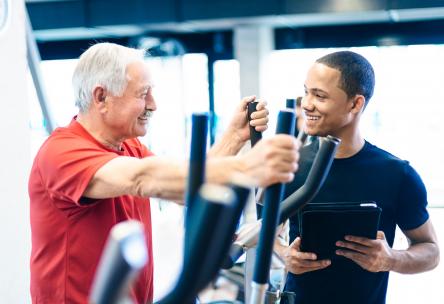A fitness pro shares the inside scoop on finding your perfect match

Congratulations! The fact that you’re considering a membership to a gym or fitness studio means that you’re serious about your health and well-being. Joining a gym isn’t the only path to getting fit, but signing up gives you easy access to expert help and a wide assortment of equipment and classes. With so many options to consider—swanky full-service wellness centers, boutique studios, no-frills clubs, or something in between—finding the right workout space for you can be challenging. Of course you want to consider such factors as costs, the contract’s fine print, and convenience, but more important are the details that will help you actually meet your fitness goals.
“There’s no one perfect gym for everyone,” says exercise physiologist and fitness educator Pete McCall, a spokesperson for the American Council on Exercise. “Finding the right fit is a matter of looking for a place that has a comfortable vibe for you and that has the right mix of staff, space, equipment, and classes that will help you improve your fitness.”
So before you sign any dotted line, read on.
1. What are your fitness goals? Just as there are trends in fashion and food, there’s always some new fitness program getting lots of buzz. But none of that matters if the workout of the moment won’t get you closer to meeting your personal health goals, says McCall. Before you go shopping for a gym, have a good grasp of what you want to gain from exercising. “A person interested in training for their first 5-K may have a lot of fun going to a studio that specializes in Spin classes,” he says, “but they’ll get more out of a place that has certified staff who can help them improve their running form, show them how to incorporate strength training, and make sure they don’t ignore their flexibility.”
2. Does the facility offer access to SilverSneakers classes and workout programs? SilverSneakers offers workout classes and amenities at 14,000 participating gyms across the country. What's more, a SilverSneakers membership will allow you to visit multiple facilities that offer the program, so you're not tied to a single gym.
And the best part of all: If you're 65 or older and enrolled in a Medicare Advantage or Medigap plan that includes the SilverSneakers program membership, you pay nothing for access. Check your eligibility now.
2. Belonging to a gym versus working out on your own. Ask yourself why you’re seeking out a community atmosphere. Maybe you like the idea of quick access to fitness pros who can answer questions or suggest new moves. If so, ask to meet a trainer or two to gauge how they interact with members. If you like to maintain anonymity in a crowd, you might be uncomfortable in a setting that feels more like a close-knit club. If you simply want a center that offers a little bit of everything so you won’t get bored, then a no-frills big-box gym may feel just right. “The bottom line,” says McCall, “is to find a place that you’ll look forward to going to on a regular basis.”
3. What does the mix of classes look like? “For your fitness level to improve, your muscles need new stimulus,” says McCall. That means workout variety. Scan the class offerings to make sure there’s a wide range of options—everything from high-intensity aerobics to classes that focus on building core strength and improving flexibility. Also check the class times against your schedule. “If you’re joining a place mainly for the group classes but can only workout at 10:30 a.m., you’ll want to find a gym that isn’t holding the same class daily at that time,” he says.
4. How are staff members trained? “Ask up front how trainers and instructors are educated and whether or not the gym or studio requires personnel to have a national certification,” says McCall. The top accrediting organizations in the United States are the American Council on Exercise, American College of Sports Medicine, International Sports Science Association, National Academy of Sports Medicine, and National Strength and Conditioning Association.
Looking for a yoga teacher? A certification from the Yoga Alliance signals that the instructor has taken several continuing education courses in teaching practices. YMCA-certified yoga instructors are also trained in general fitness and exercise methods.
Ask if at least one certified trainer always on-site and whether someone at the facility is trained in CPR and basic first aid.
5. What equipment is available, and how is it maintained? Boutique studios, which focus on just one or a handful of focused workouts, and newer, open-space play areas may not have the expected assortment of treadmills, free weights, and other machines, but McCall says it’s important for all fitness centers to have a devoted stretching area. Look for foam rollers to aid muscle recovery after a workout and stretching straps to help you get a more effective post-workout release.
Pay close attention to the cleanliness of the facility and machines. “There’s a difference between daily dust that settles on top of machines and dust bunnies growing under them,” says McCall. “If the underside isn’t clean, it tells you that the club doesn’t take much pride in maintenance.”
Final tips: Don’t join until you’ve visited at the time of day you’d be most likely to work out. You’re checking for deal breakers. Ask yourself about the overall vibe and the crowd size. Is it a place where you’ll want to be? Check the commute time too. Anything more than 15 minutes away may be tough to fit into a busy schedule.